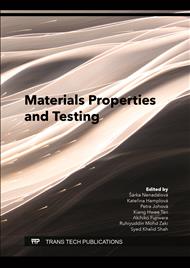[1]
M. S. AlSalhi, J. Alam, L. A. Dass, and M. Raja, Recent advances in conjugated polymers for light emitting devices, Int. J. Mol. Sci., vol. 12, no. 3 (2011) 2036–(2054).
DOI: 10.3390/ijms12032036
Google Scholar
[2]
X. W. Xu et al., Luminescent and photovoltaic properties of poly(9,9-dioctylfluorene-co-bithiophene) in organic electronic devices, Chinese Sci. Bull., vol. 57, no. 9 (2012) 970–975.
DOI: 10.1007/s11434-011-4964-3
Google Scholar
[3]
Ansari S.P, Ali. F, Conjugated Organic Polymers for Optoelectronic Devices, in: Jafar Mazumder m, Sheardown. H, Al-Ahmed A (Eds), Functional Polymers. Polymers and Polymeric Composites: A Reference Series, Springer, Cham, 2018, p.1–40.
DOI: 10.1007/978-3-319-95987-0
Google Scholar
[4]
S. Guha, M. Arif, and C. Volz, Chain morphologies in blue-emitting polyfluorenes: Impact on light-emitting diodes, Mater. Res. Soc. Symp. Proc., vol. 916 (2006) 3–13.
DOI: 10.1557/proc-0916-dd01-02
Google Scholar
[5]
W. X. Shi, N. Liu, Y. M. Zhou, and X. A. Cao, Effects of postannealing on the characteristics and reliability of polyfluorene organic light-emitting diodes, IEEE Trans. Electron Devices, vol. 66, no. 2 (2019) 1057–1062.
DOI: 10.1109/ted.2018.2888858
Google Scholar
[6]
A. Perevedentsev, N. Chander, J. S. Kim, and D. D. C. Bradley, Spectroscopic properties of poly(9,9-dioctylfluorene) thin films possessing varied fractions of β-phase chain segments: enhanced photoluminescence efficiency via conformation structuring, J. Polym. Sci. Part B Polym. Phys., vol. 54, no. 19 (2016) 1995–(2006).
DOI: 10.1002/polb.24106
Google Scholar
[7]
Schuld. N, and Wolf. B, Polymer-Solvent Interaction Parameters, in: J. Brandrup, E.H. Immergut, and E.A. Grulke (Eds.), The Wiley Database of Polymer Properties, (2003).
DOI: 10.1002/0471532053
Google Scholar
[8]
M. Grell et al., Chain geometry, solution aggregation and enhanced dichroism in the liquid-crystalline conjugated polymer poly(9,9-dioctylfluorene), Acta Polym., vol. 49, no. 8 (1998) 439–444.
DOI: 10.1002/(sici)1521-4044(199808)49:8<439::aid-apol439>3.0.co;2-a
Google Scholar
[9]
W. Chunwaschirasiri, B. Tanto, D. L. Huber, and M. J. Winokur, Chain conformations and photoluminescence of poly(di-n-octylfluorene), Phys. Rev. Lett., vol. 94, no. 10 (2005) 3–6.
DOI: 10.1103/physrevlett.94.107402
Google Scholar
[10]
Bradley. D.D, Grell. M, Long. X, Mellor. H, Grice. A.W, Inbasekaran. M, and Woo. E.P, Influence of aggregation on the optical properties of a polyfluorene, Opt. Probes of Conjug. Polym., vol. 3145 (1997) 254–259.
DOI: 10.1117/12.295530
Google Scholar
[11]
M. Campoy-Quiles, P. G. Etchegoin, and D. D. C. Bradley, On the optical anisotropy of conjugated polymer thin films, Phys. Rev. B - Condens. Matter Mater. Phys., vol. 72, no. 4 (2005) 1–16.
DOI: 10.1103/physrevb.72.045209
Google Scholar
[12]
Zhang. Qi, L. Chi, G. Hai, Y. Fang, X. Li, R. Xia, W. Huang, and E. Gu, An easy approach to control β-phase formation in PFO films for optimized emission properties, Molecules 22, no. 2 (2017) 315.
DOI: 10.3390/molecules22020315
Google Scholar
[13]
Z. Bai et al., Quantitative study on β-phase heredity based on poly(9, 9-dioctylfluorene) from solutions to films and the effect on hole mobility, J. Phys. Chem. C, vol. 120, no. 49 (2016) 27820–27828.
DOI: 10.1021/acs.jpcc.6b08941
Google Scholar
[14]
L. Huang, X. Huang, G. Sun, C. Gu, D. Lu, and Y. Ma, Study of β phase and chains aggregation degrees in poly(9,9-dioctylfluorene) (PFO) solution, J. Phys. Chem. C, vol. 116, no. 14 (2012) 7993–7999.
DOI: 10.1021/jp301102t
Google Scholar



